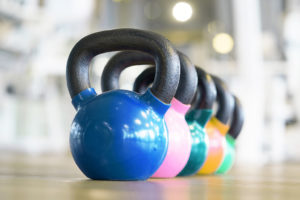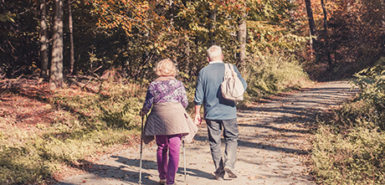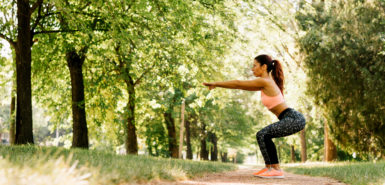
For novice to elite athletes, weightlifting with a kettlebell can enhance posture and strengthen the lower body.
Kettlebell workouts call on muscles of the posterior chain—the postural muscles of the spine along with the glutes, hamstrings and calves.
“These muscles are often overlooked in American strength training, which focuses more on cosmetic areas of the body, such as the chest, biceps, abdominals and quads,” said Jason Burgess, MS, AT, an athletic trainer with Spectrum Health Medical Group. “Training the posterior chain can improve your balance and stability, as well as limit strength imbalances that may lead to injury.”
Kettlebells offer a great rainy-day or limited-space cardio workout alternative, Burgess said.
When completed over multiple long-duration intervals, exercises such as the kettlebell swing, snatch and clean can rival running a six-minute mile.
For sports requiring horizontal acceleration and propulsion, such as sprinting, kettlebell training can be just as effective as traditional weight training—and in some cases, the kettlebell may even be the superior choice.
Pick a weight
Most kettlebell exercises are designed for a single weight, unlike dumbbells, which often require a set of two.
Also, the kettlebell handle and horns hold advantages over conventional weights, Burgess said.
The shape and grip space allow for one- or two-hand use. With the handle placed several inches from the center of the mass, dynamic exercises require more work to stabilize the kettlebell.
Kettlebell weights range from about 8 to 150 pounds, making them accessible to novices and elite athletes.
Kettlebell exercises typically require power and coordination. Selecting too much weight—a common beginner’s mistake—can cause loss of control and injury.
Burgess offered a few kettlebell weight guidelines:
- Novice men: 25 to 35 pounds
- Athletic men: 35 to 44 pounds
- Novice women: 18 to 25 pounds
- Athletic women: 25 to 35 pounds
He recommends starting with lighter weights and increasing as movements are mastered. To avoid injury, make sure you progress slowly—and stay focused on adequate range of motion.
Master the moves
Before even picking up a kettlebell, work to master the rock-back and glute bridge, Burgess said.
Kettlebells can then be added into those exercises.
From there, progress to a kneeling kettlebell deadlift and Romanian kettlebell deadlift. This can prepare you for the swing, clean and snatch progression.
The quadruped rock-back
This can help assess hip range of motion and core stability.
Start on your hands and knees with your wrists directly under your shoulders. Your knees should be under your hips, about the width you would normally squat. Feet and ankles should be engaged with the floor as if in a squatted position.
Engaging the core and maintaining a neutral spine, sit back toward your ankles as deeply as you can, then return to the start position. You should be able to move beyond 90 degrees of hip flexion while maintaining a neutral spine.
The glute bridge
Lie flat with knees bent to about 90 degrees to assess hip and core stability. Feet should be flat on the ground, about hip width. Arms should be at your side with palms facing down.
Tighten your core and engage the glutes. Push through your heels to drive your hips up until they are in line with the thighs and trunk. Pause at the top, then lower down to the start position. You should be able to drive your hips up to or just beyond neutral alignment while maintaining a flat back throughout the exercise.
Kneeling kettlebell deadlifts
Start by kneeling on the ground with knees at shoulder width. Place the kettlebell behind your back and grip it by the handle with both hands. Palms should be facing back.
Engage your core and drive your hips back towards your heels while maintaining your balance with a neutral spine. You should be able to flex your hips to about 90 degrees. Drive your hips forward to return to the start position.
Romanian kettlebell deadlifts
Start by standing with feet about shoulder width apart. Hold the kettlebell between your legs, gripping the handle with both hands and palms facing back.
Engage the core, unlock your knees and drive your hips back, similar to the kneeling deadlift. As you lower the kettlebell between your legs, maintain a neutral spine and allow for slight knee bend.
You should feel tension build in your glutes and hamstrings as you descend. When that tension limits you from pushing back any further, snap your hips forward and upward and return to the start position.
“The kettlebell is an incredibly versatile implement and an excellent choice for those wanting a new challenge in their resistance-training program,” Burgess said.
He cautioned, though, that kettlebells are not for everyone.
“Those with limited balance or mobility, especially in the hips, should stick with more foundational movements using body weight, or more stable implements, such as barbells or dumbbells,” he said.
Burgess added an important tip: Choose the right size kettlebell and progress slowly through each level of exercise—it will help you avoid injuries.
“However, novice lifters should consider working with a certified personal trainer, strength coach or movement specialist to safely get started,” Burgess said.
 /a>
/a>
 /a>
/a>
 /a>
/a>